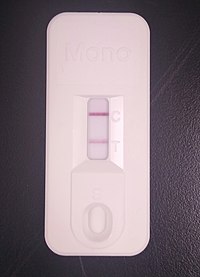Heterophile Antibody Absorbed by Beef Erythrocytes
| Heterophile antibody test | |
|---|---|
 A commercial immunochromatographic test kit for the heterophile antibody test. Solid lines are visible at the "C" (control) and "T" (exam) positions, indicating a positive result. | |
| Synonyms | Monospot examination |
| Purpose | rapid test for infectious mononucleosis |
The mononuclear spot test or monospot examination, a grade of the heterophile antibody test,[ane] is a rapid test for infectious mononucleosis due to Epstein–Barr virus (EBV). It is an comeback on the Paul–Bunnell test.[2] The exam is specific for heterophile antibodies produced by the human immune system in response to EBV infection. Commercially available test kits are 70–92% sensitive and 96–100% specific, with a lower sensitivity in the first two weeks after clinical symptoms begin.[3] [4]
The United states of america Center for Disease Control deems the monospot examination not to be very useful.[5]
Medical uses [edit]
It is indicated as a confirmatory test when a doctor suspects EBV, typically in the presence of clinical features such as fever, malaise, pharyngitis, tender lymphadenopathy (peculiarly posterior cervical; oftentimes called "tender glands") and splenomegaly.[6]
In the example of delayed or absent seroconversion, an immunofluorescence test could be used if the diagnosis is in dubiety. Information technology has the following characteristics: VCAs (Viral Capsid Antigen) of the IgM class, antibodies to EBV early antigen (anti-EA), absent-minded antibodies to EBV nuclear antigen (anti-EBNA)[ citation needed ]
Usefulness [edit]
One source states that the specificity of the test is high, virtually 100%,[7] Another source states that a number of other conditions can cause false positives.[five] Rarely, however, a faux positive heterophile antibody exam may effect from systemic lupus erythematosus, toxoplasmosis, rubella, lymphoma and leukemia.[7]
However, the sensitivity is but moderate, so a negative test does non exclude EBV. This lack of sensitivity is particularly the case in young children, many of whom will not produce detectable amounts of the heterophile antibody and will thus have a imitation negative examination result.[8]
Timing [edit]
It will generally not exist positive during the 4–vi week incubation flow before the onset of symptoms. The highest amount of heterophile antibodies occurs 2 to five weeks after the onset of symptoms.[9] If positive, it will remain so for at least six weeks.[10] An elevated heterophile antibiotic level may persist up to 1 year.[nine]
Process [edit]
The test is commonly performed using commercially available examination kits which notice the reaction of heterophile antibodies in a person'southward blood sample with horse or moo-cow reddish blood cell antigens. These test kits work on the principles of latex agglutination or immunochromatography. Using this method, the test tin be performed by individuals without specialized training, and the results may be available in as fiddling as five minutes.[8] [11]
Manual versions of the exam rely on the agglutination of horse erythrocytes by heterophile antibodies in patient serum. Heterophile ways it reacts with proteins across species lines.[12] Heterophile too can hateful that it is an antibody that reacts with antigens other than the antigen that stimulated it (an antibiotic that crossreacts).[ citation needed ] A 20% pause of equus caballus red cells is used in an isotonic three–8% sodium citrate formulation. Ane drop of the patient's serum to be tested is mixed on an opal glass slide with one driblet of a particulate interruption of guinea-pig kidney stroma, and a suspension of ox cerise cell stroma; sera and suspensions are mixed with a wooden applicator x times. 10 microliters of the equus caballus red cell suspension are so added and mixed with each drop of adsorbed serum. The mixture is left undisturbed for i infinitesimal (not rocked or shaken). Examine for the presence or absenteeism of ruddy cell agglutination. If stronger with the sera adsorbed with guinea-pig kidney, the examination is positive. If stronger with the sera adsorbed with ox red cell stroma, the test is negative. If agglutination is absent-minded in both mixtures, the test is negative. A known 'positive' and 'negative' control serum is tested with each batch of test sera.[ citation needed ]
References [edit]
- ^ Basson 5, Precipitous AA (May 1969). "Monospot: a differential slide test for infectious mononucleosis". J. Clin. Pathol. 22 (3): 324–five. doi:ten.1136/jcp.22.3.324. PMC474075. PMID 5814738.
- ^ Seitanidis, B (1969). "A comparison of the Monospot with the Paul–Bunnell test in infectious mononucleosis and other diseases". J Clin Pathol. 22 (iii): 321–3. doi:10.1136/jcp.22.three.321. PMC474073. PMID 5814737.
- ^ Elgh, F; Linderholm, 1000 (1996). "Evaluation of six commercially available kits using purified heterophile antigen for the rapid diagnosis of infectious mononucleosis compared with Epstein-Barr virus-specific serology". Clinical and Diagnostic Virology. 7 (1): 17–21. doi:10.1016/S0928-0197(96)00245-0. PMID 9077426.
- ^ Ebell, MH (1 Oct 2004). "Epstein–Barr virus infectious mononucleosis". American Family Physician. lxx (7): 1279–87. PMID 15508538.
- ^ a b "Epstein–Barr Virus and Infectious Mononucleosis Laboratory Testing". CDC. January 7, 2014. Retrieved x August 2016.
- ^ Davidson's Principles & Practices of Medicine 20th ed
- ^ a b Infectious Mononucleosis Workup from Medscape. Author: Burke A Cunha, MD; Chief Editor: Michael Stuart Statuary, Doctor. Updated: Sep 21, 2011
- ^ a b Richard L. Hodinka; Stephen A. Young; Benjamin A. Pinksy (x July 2020). Clinical Virology Transmission. Wiley. p. 233. ISBN978-1-55581-915-6.
- ^ a b Jatin Chiliad. Vyas. "Mononucleosis spot test". MedlinePlus . Retrieved 2017-06-08 . Review Date 3/thirteen/2016
- ^ "Mononucleosis" (PDF). UniversityHealthServices, Pennsylvania State University . Retrieved 2017-08-06 . Revised 06/15/2016
- ^ "Chapter 11.9.1: Epstein-Barr Virus: Introduction". Clinical Microbiology Procedures Handbook. Wiley. half-dozen Baronial 2020. ISBN978-1-55581-881-4.
- ^ "Definition of heterophil | Lexicon.com". www.dictionary.com.
Source: https://en.wikipedia.org/wiki/Heterophile_antibody_test
0 Response to "Heterophile Antibody Absorbed by Beef Erythrocytes"
Post a Comment